Article of the Month -
May 2009
|
Making Land Markets Work for All
Ms. Jude WALLACE
Centre for Spatial Data Infrastructures and Land Administration
The University of Melbourne, Australia

 This article in .pdf-format (15 pages
and 567 KB)
This article in .pdf-format (15 pages
and 567 KB)
1) This paper was prepared and
presented for the first time in session MKTl: Potential and Challenges
for Land Markets at the FIG and World Bank Conference on Land Governance
in Support of the MDGs: Responding to New Challenges, Washington DC,
USA, 9-10 March 2009.
Key words: land markets, property, administrative systems.
SUMMARY
The design of land administration systems needed to support land
markets now benefits from the broader theoretical framework of the
discipline. The arrival of new “tool box” approaches has also enriched
our capacity to design systems that work despite the diversity of
national approaches and experiences.
The central feature of land markets is the concept of property. The
concept is cerebral, conceptual and divorced from physical reality: this
is both its challenge and its weakness. The property concept appears at
an early stage in development of land markets but is not well
understood. Despite popular thinking, design of land administration
systems for land market operations does not revolve around managing
land. Rather the design revolves around management of this abstract and
cerebral concept, with management of land itself as an essential but
secondary function.
An analysis of the stages of development of systems of market
administration can help explain how markets develop abstract concepts
into commodities. The stages can help national implementation of
pro-market systems without sacrificing pro-poor initiatives. Sensible
administration should deliver a balanced concept of property that fits
both the way the local people think about their land and the capacity of
their government to manage systems.
1. THE COGNITIVE ASPECTS OF LAND
Designers of administration systems that support land markets work
must understand how these markets work and how administrative frameworks
might manage essential trading processes. This is not economics but the
practical world of managing both the obvious and the hidden processes
that people use to trade in land-based commodities. Though we can debate
the boundaries of these numbers, of the 200 or so national
jurisdictions, only about 35 offer transparent management of all the
basic processes involved in their land markets. The 35 are roughly
equivalent to OECD members and the liberal democracies of Western
capitalism. Even these 35 experience constant reifications of their
systems as they adjust to evasions, frauds, dysfunctions and
maladjustments that constantly occur. Witness the sub-prime mortgage
crisis in 2008 in the US, and its consequences through out the globe in
2009. For this lucky 35, and indeed for the rest of the world,
management of land market processes is getting more difficult.
All markets require commodities and trading systems. From a land
administration perspective, management of land market processes is
complicated and cannot be based solely on the assumption that land
markets are fundamentally about land as a commodity. In mature land
markets commodities are much more interesting than most analysts
realize. These land-related commodities have two aspects.
The popular aspect is the visible and tangible – the houses and land,
the farms, factories and raw development sites. In short, the physical
land. The analysis of the physical aspect of land markets is extensive.
These tangible “things” are popularly thought of as the commodities,
with land administration consequently concerned about their management.
Eventually, this popular approach will restrict the development of land
markets by impeding development of a property concept that allows land
markets to develop complex commodities.
The second aspect is abstract but no less a reality – it exists
however in peoples’ minds. In successful market systems the commodities
are abstract interests and rights. Their essential nature is not the
objects to which they relate but the way systems manage relationships
among people in relation to those objects (Cohen 1954). The
administrative systems define the cognitive identity of the interests so
they can be managed and traded. This cognitive aspect is in fact far
more important than the tangible aspects of land in any community in
that it delivers the capacity to use land to accelerate wealth. The
fundamental challenge for land market analysts and designers of land
administration systems is management of these transcendental aspects of
commodities. The primary commodity is the land right and its supporting
aspects of transferability, knowability, title and tenure which together
should deliver comprehensive and predictable access to opportunities to
derive wealth out of land-related interests and to manage these
opportunities according to sustainable development objectives. In market
based systems, access to and regulation of land is designed to
institutionalize a concept of property on a national scale (North 1990).
2. A LAND ADMINISTRATION APPROACH – ENGINEERING AND TOOL BOXES
Land administration is a new discipline which applies an engineering
approach to building systems that support land management and land
markets. The engineering approach has notable features. It relies on
tools to manage essential processes and functions, and tests their
performance to continually improve them. The disciplinary vision of land
administration is now extensive and focuses on land management as a
paradigm (Stig Enemark 2006). In this paradigm, the key processes are
those associated with four fundamental functions in land management:
land value, land tenure, land use and land development. Every settled
society undertakes these functions. Some use processes that develop
accidentally. Others rely on highly planned and sophisticated processes.
Successful land markets demand well run processes because they build
exceedingly complex concepts of property.
Land administration has changed dramatically since it emerged after
World War II from its more ancient historical antecedents. Figure 1
below shows the development trends in the discipline, particularly its
emergence from its technical constraints into a multi-faceted discipline
with adaptable boundaries and best practice models that emphasise
overall good governance, participation and sustainable development.
These models increasingly rely on remarkable new technologies, and
robust theories of property.
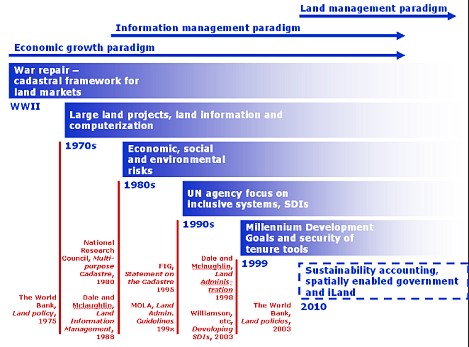
Figure 1. Development of the land administration discipline
The technical focus of modern land administration remains important
in countries with successful land markets. Figure 2 below
illustrates how these countries generate complicated land arrangements
and concepts that they initially define as pure information. The
technical approach is required to manage information, then convert
information into data to support strategic activities for modern
governments, businesses and societies.
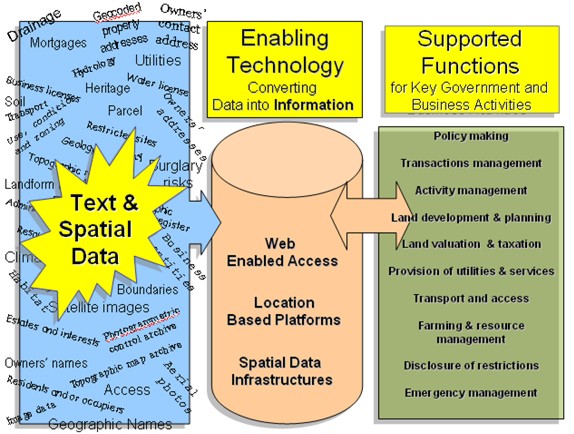
Figure 2. The modern information functions of land administration
systems
The engineering paradigm required a pragmatic approach to designing,
constructing and managing these information systems. But it in mid 1990s
it was apparent that a focus on land information was not enough.
Meanwhile technological capacity exploded through spatial enablement of
systems. The land management paradigm allowed a focus on planning and
development for sustainability to come to the forefront at the stage
when information is collected and systems are designed. Modern land
administration systems are now required implement processes that deliver
sustainability, rather than provide information to government policy
makers so they can take this responsibility. Methodologies vary, but
always involve implementation of a set of formally organized tools that
perform processes essential in land markets and land policy
implementation. The tools, and the options available to implement them,
also vary and are increasingly examined as a theoretical set or suite.
Among the many suggestions, three examples are notable.
a) The narrowly defined traditional tools in a focused land
administration approach
- Land tenure and registration systems
- Land valuation and market systems
- Land development and planning systems
- Cadastral surveying and mapping
- Benchmarking and monitoring
These are the traditional tools of Geomatics, together with
specialist professional areas of valuation, planning and business
administration. In some countries all of these fall naturally under the
heading of land administration, but most countries have separate
professional groupings to attend to discrete functions. These
traditional tools remain the core of land administration endeavors,
though the selection of options actually used is now influenced by the
broader considerations of sustainable development, and good governance.
The fundamental lesson from the last 40 years of implementation of these
specialist tools is that no one solution is capable of being universally
used. The “one size fits all” solution, even in boundary establishment
and recognition, does not work. Now land administration experts design
their solutions for a country’s land administration requirements in the
context of its existing conditions, competencies and practices.
b) The 18 land management tools of Global Land Tools Network of UN
HABITAT in Figure 3 below.
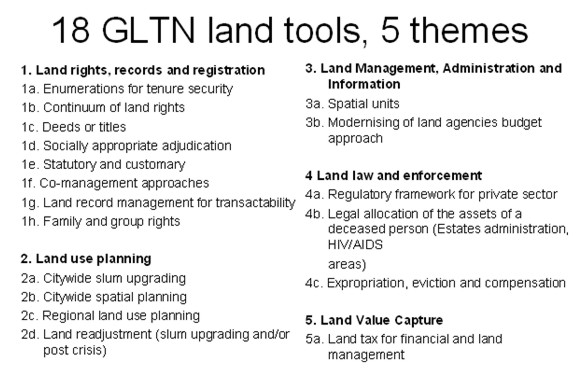
Figure 3. GLTN, HABITAT land tools
The GLTN suite of tools is designed to service pro-poor land needs,
not land markets per se. However, the tools are essential in pro-market
systems in developing countries where numbers of poor people and land
pressures over arch land policy and institutionalization of land
arrangements.
c) Tools to cover the range of issues faced by modern governments
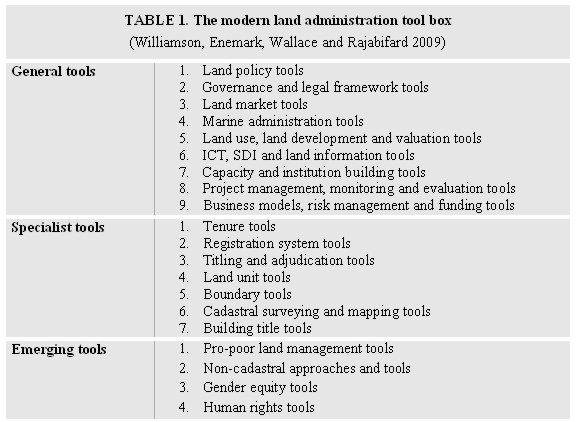
This set of tools in Table 1 above builds on traditional land
administration thinking, and takes a long range view to setting up
sustainable systems of administration, implementing social, economic and
environmental land management, and retaining sufficient flexibility to
utilize the newest appropriate technologies if and when they appear.
This increasing use of tools, seen also in the parallel attempts to
institutionalize good governance standards in national administration,
is happily called “the toolbox approach”. The toolbox idea is both
fertile and easy to understand.
3. BUILDING LAND MARKET TOOLS
Toolboxes needed for modern land management share one thing. While
they do not demand a market approach be adopted for land distribution,
they do demand all decision-makers appreciate the difficulties and the
challenges involved in establishing systems to manage ordinary processes
related to local land. These three tool boxes acknowledge that land
markets involve processes that must be managed and seek to move
management from informal systems to formal sectors of government. They
all emphasise the fundamental starting points in design of any system
are existing public expectations and practices. Thus land administration
experts do not suggest that implementation of a tool or a suite of tools
will, of itself, deliver national capacity to manage a local land
market. To deliver a land market, the tools need to institutionalize a
national concept of property in land.
This property concept is complicated. But there is really no mystery
about it. Communities that understand this concept are ready for a
modern land market; others are not. Many previous attempts to introduce
markets involved constructing the land administration systems without
regard to the society’s capacity or willingness of intended
beneficiaries to use or relate to land markets, with unintended and
often negative consequences.
Institutionalization of property involves a tenure system (legal
tools, usually legislation) and a titling system (land measurement,
identification and management of transactions: typically through
registries and cadastres). Economic operation of land markets also
depends on related markets for agricultural products, labor, and money.
The inter-relationships between these markets will vary from
place-to-place and time-to-time. As we all know, these
inter-relationships are often unpredictable.
4. PROPERTY IN LAND ADMINISTRATION
The idea of “passporting” property is a major contribution of
Hernandes de Soto (2000) to our understanding of land markets. It led to
an assumption that passporting processes suitable for all nations could
be designed and implemented through top-down national policy and
development aid programs that emulated systems used in successful land
market countries. This proved much more difficult for reasons now
understood to relate to the need to base administrative or legal reforms
on the ideas of land that already operate in nation states, indeed even
in small areas within nation states. In short, the institution of
property is not transferable by introduction of technical and
administrative systems and processes – it must be built by people
themselves as they absorb the pressures of their lives and internalize
change.
Market systems rely on “private property”, an idea which emphasizes
only one side of the property function – identification of people with
control over interests. However, the property function required
articulation of fences around all human behaviour in relation to land
and opportunities (Reed 2003). In an ideal world, the property
institution would move the fence defining property units (or market
commodities) to ensure a balance between the various rights, including
the rights of the state, to facilitate land markets, sustainability and
land distribution reform. Adequate enforcement of private property would
allow people in control of other people’s resources to take only those
risks that they would take if they personally owned the resources. And
the property institution would incorporate the European,
inter-generational model of land exploitation by ensuring that public
interests in sustainable development were recognized (Raff 2003). The
ultimate justification for private property is the common good and thus
the applications of private property must ultimately be socially
defensible.
Another way of explaining this relies on legal theory. The lawyer’s
idea of property is a duality: it allows the owner of property (whether
the asset is tangible or intangible) power against all takers, with a
co-relative imposition of responsibility to respect this power on all
potential takers, including the state. The lawyer therefore requires
land administrators to design processes that respect the duality of land
rights. Rights always involve someone with power and someone with a duty
to respect the power. Whatever the legal theory (natural law,
empiricism, American legal realism, legal positivism, critical legal
theory, and so on), the duality remains. Thus the land administrator is
faced with not just tracking the owner, but with systematically
identifying whom in the socio legal order must respond to ownership and
how they must respond.
Lawyers also differentiate property rights from all other kinds of
legal rights: we notionally attach the legal right to the “thing” (which
may be abstract – such as a share in a company, or a debt, or freehold
ownership). Thus we are able to attach rights to an interest in land
irrespective of who owns the parcel and when they obtained their
interest. If the right relates to property interests in land, it
automatically binds subsequent owners. Thus property rights subsist
beyond the immediate parties who created them. Mere contractual rights,
by contrast, can be asserted only by the parties to the contract. This
is why banks and money lenders want “security” over the land when they
lend to home buyers and developers. And why a mortgage system needs to
deliver a proprietary right enforceable against all takers of the land
beyond the person who obtained the initial loan.
Any group of people who organise access to and distribution of their
land will use a theory of property. Organisation presupposes a system of
rules (Llewellyn 1940). Prior to this, the group will rely on exercise
of brute force or power to assert claims to possession. In practical
terms, a theory of property used in a nation is fundamentally connected
with the heritage of its system of rules, notably its law. For
convenience we can divide the world into seven anthropological legal
orders or “families”: Chthonic (recycle the World); Talmudic (Perfect
Author); Civil Law (Centrality of the person); Islamic (Law of a Later
Revelation); Common Law (Ethic of Adjudication); Hindu (The Law as King,
but which law; and Asian, (Make it New - with Marx) (Glenn 2004).
For land administrators diversity of legal origins poses a massive
problem of communication. Our individual familiarity with property
theory in our home jurisdiction undermines our ability to interpret the
idiosyncrasies of any other property theory. This is compounded by the
European influences in colonization shown in Figure 3 below which
created two mega families in the world finance, constitutional patterns,
and legal orders: the common law or British empire countries, and the
civil law countries.

Figure 3. World Bank map of legal origin, p 85.
From the land administration perspective, the major issue of
servicing land markets revolves around the quite different concepts of
land ownership, and hence property in land, in these two dominant legal
families.
Relative property theory. Common law countries have the
benefit of an open-ended and relativistic theory of property. To
illustrate (with over-simplification): in Australia, we can have three
perfectly sound, legally recognized owners of the same land at the same
time. The first is the legal owner (usually the registered owner with a
Torrens title). The second is the equitable owner (the person who
benefits from the land because the legal owner holds on a trust). The
third is the person who has possession of the land – if that person
holds on for a 12 (in most states) year period, the legal owner and the
equitable owner cannot reclaim the land. English trained lawyers are
therefore familiar with having multiple owners each holding a freehold
estate in land simultaneously recognized in a complex system of
priorities. The system requires complex priorities rules for its daily
operation. It is so complicated, that its inventor nation, England,
renovated it in 1925 by abolishing all its legal interests except
ownership and leases, including mortgages, through reforms that emanated
from one of the most conservative parliamentary institution in the
world’s history, the House of Lords. Ex colonial nations have tended to
preserve the old system in its full glory.
In Australia, perhaps the most counter-intuitive result of relative
property is the status of most owners of the legal freehold in valuable
land. A great deal of commercial, agricultural and industrial land is
owned by a legal owner who is a shell: the real owners are the
beneficiaries of hidden trusts. The state and the public at large do not
know about these trusts. They are not on the public record, and indeed
their registration is forbidden. The result is that land markets in
these Australian jurisdictions operate without the real owners of most
commercial land being on the public register, and without any adverse
implications for market operations. This is definitely not a system to
be emulated in other countries. However, it illustrates that markets can
be both transparent and effective for trading purposes without all
important interests being in a public register.
The idea of relative property in land also led to another notable
consequence: the English law recognizes the estate in land, not the
land, as the thing that is owned. Thus a tenant’s home can be burned,
but his lease still exists and his rent must still be paid. Flying
freeholds (with no “land” at all) were recognized in Australia with
ease, in the form of a building extending over a laneway, then in a
simple strata title system invented in the 1960s. Condominium owners
still own their estates despite destruction of the entire building. In
the cut and thrust of a robust property market, the relativities in
English influenced systems facilitated a stream of inventiveness that
demanded constant change in the legal and administrative systems.
Civil law systems. The property system in civil law is
different and recognizes a much more absolutist concept of owner, going
back to Roman law. Without the relativities, concepts such as trusts
which split ownership into two property rights (one legal and one
equitable), and then split ownership and management from benefits, must
be built by other methods, typically statutory. The concept of land is
rigid and recognition of the strata concepts is inhibited (Stoter 2004).
5. UNBUNDLING LAND
In modern land markets the number and nature of property based
commodities are unlimited. Since the mid 1990’s, new processes of
commodification are especially challenging for land management because
they involve “unbundling” land into separate commodities. Opportunities
related to the land itself, minerals and petroleum, water, fauna, flora,
tradable permits and credits in, for example, carbon credits, dry-land
salinity credits, planning opportunities, waste management rights, and
so on, are repackaged as tradable assets. The idea comes from using
market based instruments (MBI) or incentive instruments for environment
and resource management. These initiatives borrow heavily from property
theory and from the main characteristics of Western property:
exclusivity, duration, quality of title, transferability, divisibility
and flexibility. They all require an administrative infrastructure,
frequently incorporated into land administration, but sometimes built
separately. Analysis of infrastructure needed to manage these
commodities to date concentrates on registration, indefeasible title,
mortgageability, and compensation for acquisition. Overall, these
developments challenge a nation’s capacity to manage land holistically,
unless the design of the administrative arrangements and the information
generated are related back into LAS and land information. Moreover,
little theoretical or practical research is available on how to
incorporate social and stewardship values equivalent to the substantial
restrictions on land into these new commodities.
6. STAGES IN DEVELOPMENT OF LAND MARKET ADMINISTRATION SYSTEMS
The land administrator needs to appreciate these fundamental
differences in the concept of property in land among these two legal
families and to skillfully unpack the threads of historical and social
development of any local property theory. The administrator also needs
to understand how to build supporting infrastructure to service markets
as they develop through stages. In Figure 4 below, an heuristic
(not empirical) set of stages is suggested to facilitate our
understanding of the functions that land administration systems need to
perform as they mature to meet modern land market needs (Wallace and
Williamson 2006).
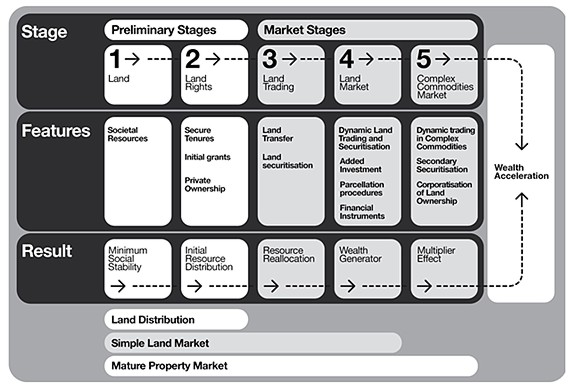
Figure 4. Stages in land market development
An analysis of these stages is already available (Wallace and
Williamson 2006). While markets depend on capacity to define commodities
in the form of rights and interests that are recognised as property,
processes involved are typically mixed up with land trading and
marketing. For a country to achieve a land market, its policy makers
must obtain public commitment to the institution of property in land.
This involves creating rights and interests that stabilise land
distribution and generate capital. While land rights can exist without a
market, markets cannot exist without land rights. Tradable land rights
are the outcome of the institution of property. Robust land rights and
an effective LAS are necessary, though not sufficient, for success in
the later market stages.
In order to explain these relationships and functions, Table 2
below provides a short introduction to the nature and content of each
stage. The important message is to understand that a system needs to be
able to move from a passporting land ownership to a passporting system
capable of generating complex cognitive commodities on an open-ended
basis, hopefully with the degree of regulation that ensures the various
interests remain in a socially and economically acceptable balance.
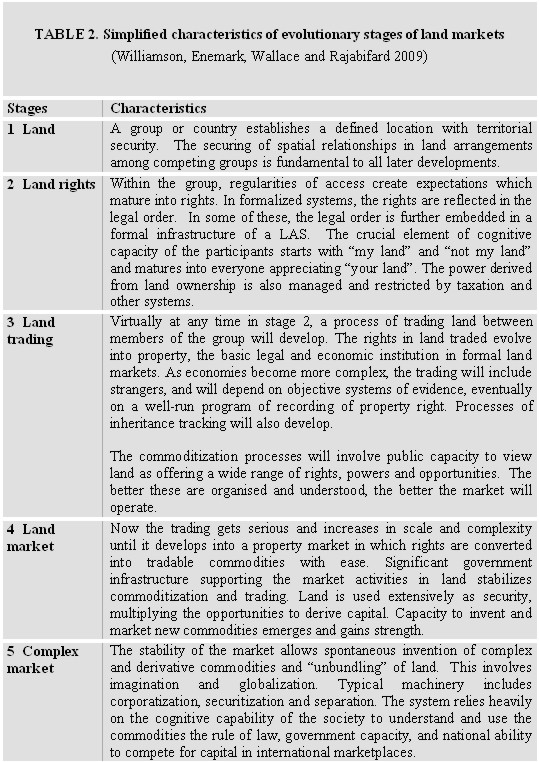
7. INSTITUTIONALIZING PROPERTY FOR EFFECTIVE LAND MARKETS
The most significant effort in developing land markets work must be
devoted to building the cognitive capacity of the public to
understand the market related concept of property (Figure 5
below). This remains essential even in centralist economies (for
example, in Vietnam and China) where land remains an asset of the
government for the benefit of all citizens. Thus systems that manage
land market processes must be built in the context of government
commitment to the public, and the co-relative commitment of people to
the formal processes. Otherwise they will boycott the formalities. The
formal processes must allow public participation, be transparent, allow
scope for private inventiveness and inclusion of new commodities. The
processes must facilitate abstract thinking and shared understandings of
the property model. And all of these must be achieved while respecting
local ideas of land and its significance to its users.
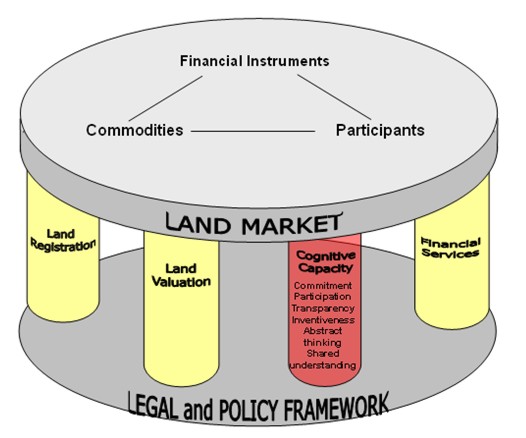
Figure 5. Cognitive capacity in land markets
(Wallace and Williamson 2006, based on Dale’s Three Pillars Diagram,
2000 P.IV)
8. CONCLUSIONS
The demands on land administration systems will continue to grow.
Their designers must anticipate sources of disputation and seek to
eliminate them, while addressing inevitable failures and disputes.
Articulation of public and private roles in relation to land must
encourage cooperation and sharing of common goals. Regulation, the rent
seekers’ bible, must be limited in favour of creativity and
inventiveness. Land administration systems need to be spatially enabled
to assist information sharing and streamlining of processes in
government, business and society at large. The historical constraints on
tenures need to be relaxed so that traditional and modern communal
systems are protected within a market context. Land administration
theory has evolved to define, if not meet, these issues. And hopefully,
the discipline now stands ready to meet the challenges of stabilizing
land market process to meet the pressures of global economic recession
by preserving and enhancing the social utility of our property
institutions.
ACKNOWLEDGEMENTS
The teamwork of staff and students at the Centre for Spatial Data
Infrastructures and Land Administration underlies this paper,
particularly Rohan Bennet, Kate Dalrymple and Mohsen Kalantiri (whose
PhD theses are on the centre’s website:
www.csdila.unimelb.edu.au).
Acknowledgment is especially due to my coauthors of a forthcoming book
on land administration, Ian Williamson, Stig Enemark and Abbas
Rajabifard. Any errors are the fault of the author.
REFERENCES
Cohen, Felix, 1954, Dialogue on Private Property, 9 Rutgers
Law Review 357.
Dale, P. 2000, The importance of land administration in the
development of land markets: A global perspective, in Land
Markets and Land Consolidation in Eastern Europe,
http://www.landentwicklung-muenchen.de/aktuelle_aufsaetze_extern/seminar_04.pdf
De Soto, Hernandes, 2000, The Mystery of Capital. Why Capitalism
Triumphs in the West and fails Everywhere else, Bantam Press,
London.
Enemark, Stig, 2006, The land Management Paradigm for
Institutional Development, in Williamson, Ian, Stig Enemark and Jude
Wallace (eds), Sustainability and Land Administration, Department
of Geomatics, Melbourne. Pp17-30.
Glenn, Patrick, 2007, Legal Traditions of the World,
Sustainable Developments in Law, 3rd ed. 2007 Oxford University Press,
Oxford.
North, Douglass. C. 1990. Institutions, Institutional Change and
Economic Performance, Cambridge University Press, Cambridge.
Raff, M. (2003) Private Property and Environmental Responsibility:
A Comparative Study of German Real Property Law, Leiden, The
Netherlands: Kluwer Law International.
Reed, O. Lee, 2003, Reductionism in Property, Liberty, and
Corporate Governance, 36 Vanderbilt Journal of Transnational Law
367.
Stoter, Jantine E. 2004, 3DCadastre, Geodetic Commission, The
Netherlands.
Wallace and Williamson, 2006, Building Land Markets, Land
Use Policy Journal,
Williamson, Enemark, Wallace and Abbas Rajabifard, 2009
(forthcoming), ESRI Publications, San Diego.
BIOGRAPHICAL NOTES
Jude Wallace is a land policy lawyer and researcher. She works
in international land administration, dealing with systems to deliver
social, environmental and economic sustainability. Her policy analysis
spans all land tenure types used by the world’s people, all methods of
securing access to land and resources and the expanding opportunities
created by new technologies.
Her research includes designing modern land administration systems
for complex property markets, betterment systems for rural land tenures
systems, and modeling of processes and transactions associated with
social transitions and land markets. Her international consultancy work
includes projects in Australia, United Kingdom, Indonesia, East Timor,
Vietnam and Iran. As Law Reform Commissioner for Victoria she worked on
reforms of land law and administration, mining law, and subdivision law
and procedures.
CONTACTS
Ms. Jude Wallace
Centre for Spatial Data Infrastructures and Land Administration
Department of Geomatics
The University of Melbourne
Melbourne
AUSTRALIA 3010
Tel. + 61 3 8344 3427
Fax + 61 3 9347 2916
Email:
j.wallace@unimelb.edu.au
Web site:
http://www.geom.unimelb.edu.au/people/jwallace.html
 |
































